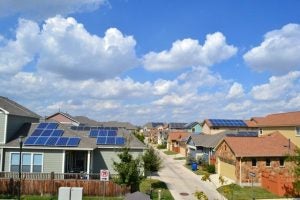 Distributed resources – like residential solar, storage, and electric cars – are becoming more mainstream every day. This presents new challenges for utilities and utility regulators who are struggling to capture their benefits, while balancing shareholder interests and reliability.
Distributed resources – like residential solar, storage, and electric cars – are becoming more mainstream every day. This presents new challenges for utilities and utility regulators who are struggling to capture their benefits, while balancing shareholder interests and reliability.
To help utility commissions around the U.S. navigate the challenges, considerations, and policy developments related to the emergence of distributed energy resources, the National Association of Utility Regulators Association (NARUC) board of directors accepted a rate manual written by its staff subcommittee at its annual meeting. The Distributed Energy Resource Compensation Manual supports a deliberate, reasoned approach to making rate design changes by providing practical guidance to its members.
Why is the manual important?
In 2013, Peter Kind wrote a paper for the Edison Electric Institute entitled “Disruptive Challenges” foreshadowing the impact of distributed energy resources on the utility industry. At the end of the paper, he recommended that utilities take immediate action to increase the fixed amounts collected in a customer’s bill regardless of how much a customer uses to ensure revenue certainty and stability.
The utilities have been quick to respond, despite Mr. Kind’s retraction of his advice in 2015. For example, according to the North Carolina Clean Energy Technology Center, 42 states considered increasing fixed charges in the second quarter of 2016 – and this number was down from the first quarter, when 61 utilities in 30 states proposed fixed-charge increases.
[Tweet “Utility Regulators Guided To Set New Rates Deliberately, Using Data”]
While increases to fixed charges have proven to be popular among utilities, they have been vigorously opposed and largely unsuccessful before regulators. According to the North Carolina report, in over half the cases decided so far in 2016, utilities have not been allowed to increase the fixed charge. Rate design is clearly an area of significant contention and is requiring increasing attention and resources from utility regulators and parties in contested proceedings. The Manual provides a consistent framework for evaluating rate-design decisions in the age of distributed energy resources.
Deliberate, data-driven approach
NARUC rolled out a draft rate-design manual at its summer meeting, and all interested parties had a chance to submit written comments. The staff subcommittee received comments from 76 parties, and after reviewing the comments, the manual expanded from 66 pages to 180. Additions include case studies for reference and recommended questions for state commissions to consider as they consider new rate plans.
Industry comments on the draft Manual (once again) advocated for immediate, proactive action on rate design. However, the final manual rejected this call for fast, preemptive change and adopts a very deliberate approach based on data. The manual makes the case that penetration of distributed resources remains low in most of the United States and suggests that states carefully monitor the pace of adoption and use the time to investigate, learn, and ask a series of questions to test out proposed designs against policy goals.
This approach is consistent with comments sent to NARUC in June by 32 environmental advocates (including Environmental Defense Fund), low-income advocates, technology-specific advocates, and consumer advocates from across the country. That letter asked that commissions adopt a collaborative approach to rate design change, in addition to a data-driven process. The manual builds on that request and provides a practical approach to monitoring and gathering information for thoughtful change.
Several of the comments noted that the tone of the draft manual could be improved as it appeared to portray the new resources as causing problems to be solved, as opposed to viewing them as technologies offering flexibility and opportunities for optimizing grid assets, reducing greenhouse gases, and providing consumer benefits. The final manual stresses throughout that utility commissions must not only assess the costs related to distributed energy resources, but also take into consideration their potential benefits. That’s progress.
What’s next?
The final chapter of the manual is entitled ‘A Path Forward for Regulators.’ While NARUC does not have any authority to bind its members, the guidance offered in the manual provides a way to get beyond what some have referred to as regulatory bickering, to understanding where, when, and how these new energy resources impact the grid and can be used for everyone’s benefit. It is my hope that regulators will use this manual to implement thoughtful, data-driven rate design change that works for all involved.